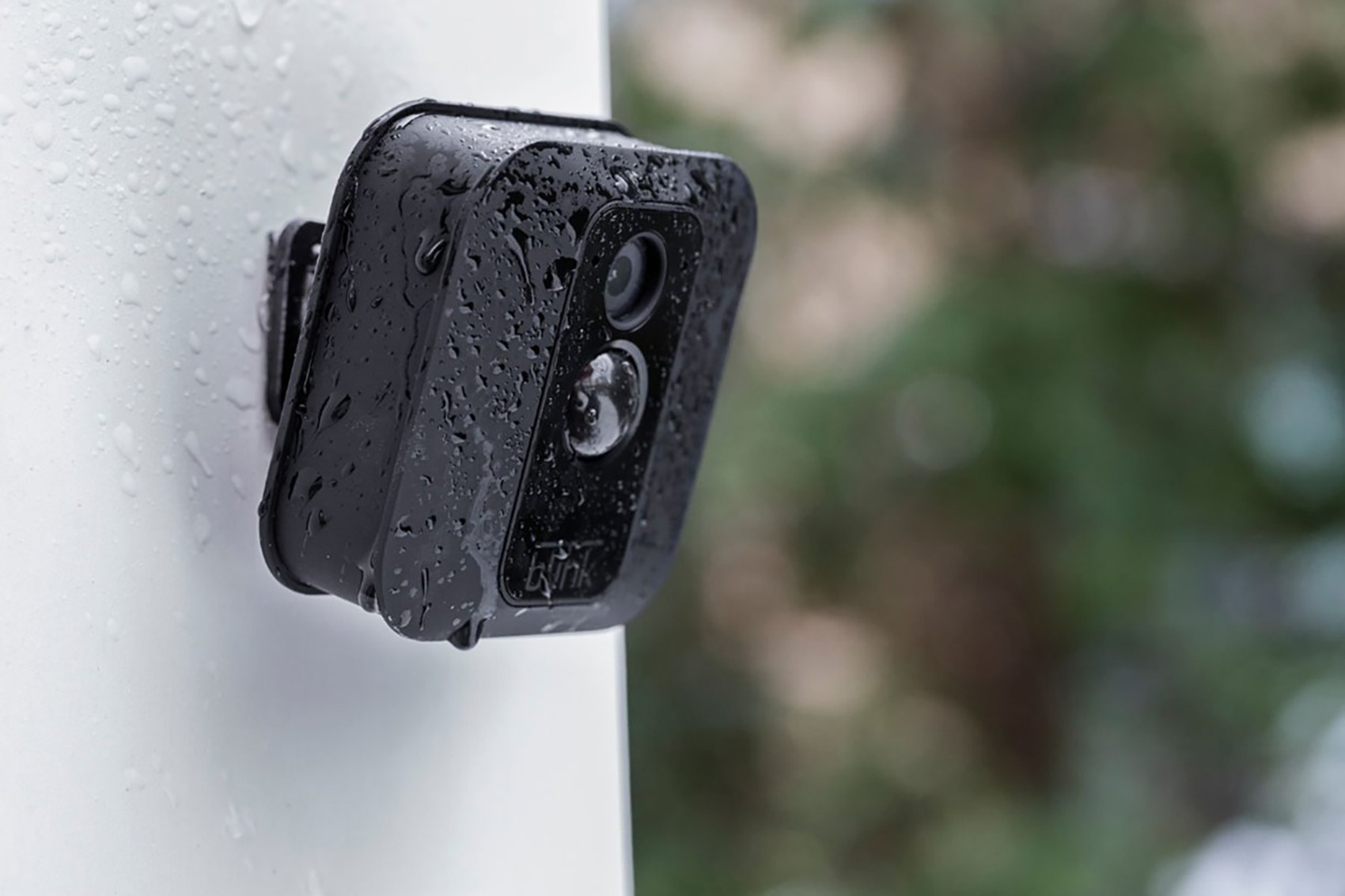Blink Camera Armed Vs Unarmed
Arming a Blink Camera enables motion detection, video recording, and push notification alerts to your smartphone when motion is detected vs. unarming a Blink Camera which disables all of these functions. However, you can access the Live View of your Blink Camera at any time no matter if it’s armed or unarmed.
The default mode of a Blink camera is unarmed. When the cam is unarmed, its motion detection is turned off and you won’t receive notifications on your phone or record video. Arming the cam turns on motion detection, automatic video recording, and push notifications whenever motion is detected. This can be both a benefit and a problem depending on when you arm the camera.
- “Armed” mode is the active surveillance state of the Blink camera. When the camera is Armed, it becomes alert to any motion in its field of view. If motion is detected, the camera automatically starts recording and sends a push notification to your connected device, letting you know that something is happening.
- “Unarmed” mode is a passive state where the Blink camera will not record or send notifications when it detects motion. This mode is especially useful when there are a lot of people moving around in its field of view, such as during a party. It helps prevent unnecessary alerts and recordings, saves battery life and bandwidth, as the camera isn’t actively recording or transmitting data.
The benefit of having two modes is flexibility. You can customize your Blink camera to arm or disarm automatically based on specific schedules or times of day when you’re asleep, not at home, or active around the house.
Understanding both modes and their pros vs cons can help you use your Blink camera more effectively.
How To Arm / Disarm Blink Camera
The best way to arm/disarm a Blink camera is via the Blink app. Remember, by default a Blink camera is disarmed. So when you open the app for the first time, you’re only option is to arm the camera. Once armed, you’ll be able to disarm it with the app. Switching between “Armed” and “Disarmed” modes is very simple and easy to do.
Here’s how to do it:
- Open the Blink Home Monitor App and locate the Camera you want to Arm/Disarm.
- Navigate to the bottom of the screen where you’ll find a tile marked Armed and Disarmed.
- Tap on the Armed button to arm the System, then tap Disarmed to disarm it.
Once your Blink camera is Armed, you’ll notice some new icons that pop up next to the Camera tiles. This is because in “Armed” mode your camera has new functionality like active monitoring, video recording and notifications.
What Does Blink Camera Armed Setting Do?
When your Blink camera is set to the “Armed” mode, its motion detection is turned on and it enters a state of active surveillance. When the camera detects motion within its field of vision, it will automatically record video and send you notifications on your connected device. It’s like the camera is on high alert, ready to inform you about any activity it detects.
To “Arm” your Blink camera, tap “Armed” at the bottom of the Home screen. A message will display confirming that your system has been “Armed” or “Disarmed”. Once the system is Armed, any motion detected by your cameras will send a notification to your mobile device and start recording.
- When you want your home to be more secure, arm the cameras so they’ll record motion and send you notifications.
- Disarm the cameras when you’re home and in front of the cameras so they don’t record mundane activities like you mowing the lawn.
Blink cameras can function as effective home security devices when put in armed mode. They come with various features designed to enhance the surveillance of your property. Among the most critical of these features are the “Armed” and “Unarmed” settings. These modes are essentially the action settings of the camera, which determine how it behaves in response to detected motion.
What Happens When A Blink Camera Is Armed?
When a Blink camera is in “Armed” mode, its motion detectors turn on and it actively monitors for movement. Once movement is detected, the camera automatically begins recording a clip of the activity. This recorded clip is then uploaded to the cloud, where it can be viewed through the Blink app on your smartphone or tablet. At the same time, you’ll receive a push notification on your connected device alerting you of the detected motion.
How Does A Blink Camera Record & Alert In Armed Mode?
A Blink camera’s “Armed” mode uses the camera’s inbuilt motion sensor to detect movement. When motion is detected, it automatically triggers the recording of a video clip for a set duration, which can be customized in the settings. The camera then sends an alert via push notification to your connected device and uploads a copy of the video to the cloud.
The push notification includes a link to the recorded video clip, making it quick and easy for you to access and review the footage.
Once the Blink is in “Armed” mode, all of these functions happen automatically.
When Should A Blink Camera Be Armed
The best time to arm your Blink camera is when you’re away, sleeping, or want more security monitoring around the camera. For example, I set all my Blink cameras to arm just after I leave for work and then again at night when everyone’s inside. But I disarm them when I get home from work so they don’t record me getting the mail or mowing the lawn.
I use Blink cameras with solar power to monitor all of our construction sites so I know what’s going on when no one is there. I arm the cameras at night or on days when no work is being done so I can secure the property and our materials. But I disarm the cameras when work is being done so I’m not recording activity all day long.
Here are some times when arming your Blink camera would be most beneficial:
- When you’re at work
- During the night when everyone is asleep.
- When on vacation
- Whenever the property is vacant
“Armed” mode is great for monitoring areas of your property that are usually activity-free, like parts of the back or side yard where no one goes, a garage, or a tool shed.
How To Set A Blink Camera To Armed Mode
Setting your Blink camera to “Armed” mode is a simple process done via the Blink app. Once you open the app > navigate to the system settings > find the option to “Arm” or “Disarm” each camera individually or all cameras at once > select “Arm” to activate “Armed” mode on the selected camera.
Blink cameras start off in “Disarmed” mode by default and do not arm themselves. To use “Arm” mode, you have to arm the cameras manually one by one or all at once in the Blink app.
You can also schedule “Armed” mode to automatically activate during certain hours of the day in the settings section. This is a great feature if you arm and disarm them at the same time every day.
Pros & Cons Of Blink Camera Armed Mode
The best thing about a Blink camera’s “Armed” mode is that it actively provides surveillance, monitoring, video recording, and notifications automatically, whether you’re home or away. “Armed” mode is a proactive approach to home security, ensuring you’re instantly alerted to any activity within the visual range of the camera.
However, an armed Blink camera can be a double-edged sword. On the one hand, it offers peace of mind, knowing that your property is under constant surveillance. But, if the sensitivity of the motion sensor is set too high, or if the camera overlooks a busy area, you may receive frequent alerts, which eats up battery life and cloud storage space.
- A Blink camera’s “Arm” mode should be used when it’s needed most, such as when you’re away or sleeping.
- But it shouldn’t be used when you’re active within the camera’s field of vision, because it will record and notify you non-stop.
A balance in customizing the settings according to your specific needs and the camera’s location is very important.
What Does Blink Camera Unarmed Setting Do?
Unlike a Blink camera’s “Armed” mode, “Unarmed” mode is a passive state in which the Blink camera will not record or send notifications even when it detects motion. This is a default setting for the camera when you open it from the box. Essentially, while the camera is on and functioning, it’s not actively monitoring or alerting you when it detects movement in its field of view.
All Blink cameras start off disarmed. This is the default start of the camera which must be changed to “Armed” mode when you want it to actively monitor, record and notify you.
What Happens When Blink Camera is Unarmed?
When the Blink camera is “Unarmed”, it essentially goes into a passive surveillance state. It continues to operate, but it won’t trigger recording or notifications upon detecting motion. This means that while you can still access the camera’s live view feed manually, it won’t automatically capture video clips of any detected motion events. and won’t notify you when it detects motion.
Arming and disarming a Blink camera activates or deactivates automatic video recording and notification alerts when it detects motion.
How Does Blink Camera Operate In Unarmed Mode?
“Unarmed” mode deactivates a Blink camera’s motion detection, automatic video recording, and notification functionality. But it doesn’t mean the camera is off, rather, it’s like putting it on standby. You can still manually access the live feed, but automatic motion-triggered recording and alerting are disabled.
This means the camera won’t send any push notifications to your connected device or record video when it detects motion. But you can still access the camera’s feed at any time with your Blink app.
When Should I Use Blink Camera Unarmed Mode?
A Blink camera’s “Unarmed” mode is best in situations where you don’t want to be bombarded with constant motion alerts or when you don’t need active surveillance. For example, using “Unarmed” mode during a party in the vision of a Blink camera prevents you from being overloaded with constant notifications and video recordings.
If there are periods when you’re home and moving around, “Unarmed” mode ensures the camera isn’t constantly triggered, saving on battery life and bandwidth.
- I use Blink camera’s on all of our job sites, but set them to “Unarmed” when we’re working.
- “Unarmed” mode is great at home when I’m mowing the lawn or playing outside with the kids.
- Any time I’m in front of my Blink cameras, I generally disarm them.
I typically keep my Blink cameras disarmed by default but switch them to armed when I want monitoring. For example, when I’m washing my cars on the weekend I don’t want to trigger the Blink every few minutes as I move. But I want monitoring at night when I’m sleeping, watching a movie, or away from home.
How To Set A Blink Camera To “Unarmed” Mode
Setting your Blink camera to “Unarmed” mode is straightforward and done via the Blink app. Open the app > navigate to the system settings > find the option to “Arm” or “Disarm” each camera individually or all cameras at once > select “Disarm” to activate “Unarmed” mode on the selected camera.
Blink cameras start off in “Unarmed” mode by default and do not arm themselves. So the only time you’ll have to disarm them is after you’ve armed a camera.
You can also schedule “Armed” and “Unarmed” modes to automatically activate during certain hours of the day in the settings section. This is a great feature if you arm and disarm your cameras at the same time every day.
Pros & Cons Of Blink Camera Unarmed Mode
While the “Unarmed” mode helps reduce unnecessary alerts and saves on battery life and bandwidth, it also means the camera isn’t actively securing your property. It’s not the best choice when you’re away from home or when you want active monitoring and notifications.
- Whenever I’m away from home, distracted, or sleeping, I always arm my cameras.
- I don’t arm my Blink cameras when barbecuing, having a party in the backyard, or mowing the lawn. If you do, the cameras will keep recording and sending you lots of notifications for no reason.
It’s important to select the appropriate mode for the right situation when using a Blink camera. And remember, the default setting is unarmed. So remember to arm the cameras when you want monitoring or set a schedule in the settings.
Blink Camera Armed Vs Unarmed Mode
A Blink camera’s “Armed” and “Unarmed” settings serve distinct purposes and are suitable for different scenarios. Here’s a comparison to help you understand the two settings a little better.
| Armed | Unarmed | |
| Functionality | Active surveillance, triggers recording and sends alerts on motion detection | Passive surveillance, no automatic recording or alerts, despite detected motion |
| Ideal Scenarios | Property is vacant, during the night or in areas with expected low activity | High activity within camera’s view, when home and moving around |
| Battery and bandwidth usage | Higher due to constant motion monitoring and recording | Lower as there’s no automatic recording or notifications |
| User notifications | Sends push notifications on detecting motion | No push notifications, regardless of detected motion |
The “Armed” setting is best when you require active monitoring and want to be instantly alerted about any motion in the camera’s field of view.
Here are a few situations when you should consider arming the camera:
- When the property is vacant
- During night hours
- When you’re at work
The “Unarmed” setting is best for periods or areas of high activity, where motion alerts would be excessive and unnecessary.
Here are a few situations when you should consider disarming the camera:
- When people are at home and moving around
- During events where there will be lots of motion
Remember that Blink cameras are in unarmed mode by default. When you’re ready to arm them, you can do it in the Blink app. Then use the app again to disarm them.
To arm or disarm a Blink camera, open the Blink app > navigate to the system settings > find the option to “Arm” or “Disarm” each camera individually or all cameras at once > select “Arm” to activate “Armed” mode or “Disarm” to activate “Unarmed” mode on the selected camera.
Energy Consumption and Bandwidth Usage
When a Blink camera is “Armed”, the camera is constantly on alert. This can lead to more frequent recording and notifications if there’s lots of movement. The result is higher battery and bandwidth usage. This is due to the camera capturing and uploading video clips to the cloud whenever motion is detected.
“Unarmed” mode is more energy-efficient and uses less bandwidth because it doesn’t record or send alerts upon detecting motion. This setting can be a strategic choice to maximize the camera’s battery life and manage your internet bandwidth more effectively. But you lose real-time active monitoring and automatic video recording and notifications.
The Pros Vs Cons Of Blink Camera Armed & Disarmed Modes
Both “Armed” and “Unarmed” modes have their own advantages and disadvantages depending on the situation.
- “Armed” mode provides peace of mind during vacations or at night because any motion will trigger an automatic alert and video recording. But if you leave it on while mowing the lawn, you’ll get tons of unnecessary videos and notifications of yourself.
- “Unarmed” mode ensures that you’re not bombarded with notifications during events with expected high activity. For example, during a party or when washing your car. This saves bandwidth, cloud storage space, and battery power. But you lose active monitoring, video recording, and notifications.
Understanding both settings, how they function, and when to use them can help you utilize your Blink camera more effectively.
Based on your specific needs, you can select the appropriate mode for the situation. This flexibility enhances your home’s security while managing alerts, recordings, battery life, and bandwidth usage efficiently.
Tips For Using Blink Camera Armed & Disarmed Mode
Here are some helpful tips I’ve learned by using Blink cameras at home and on all of our job sites.
- Scheduled Arming: Use the scheduling feature in the Blink app to automatically switch between “Armed” and “Unarmed” modes based on your typical routine. This is a great feature to use if you follow a set schedule.
- Utilize Multiple Cameras: If you have multiple Blink cameras, you can set different modes for different cameras based on their locations. For example, I keep the cameras on the sides of my house armed all the time because no one ever goes near them.
- Adjust Motion Sensitivity: In “Armed” mode, you can manage the motion sensitivity to control the frequency of alerts. Reducing sensitivity helps avoid false alarms from small movements by my dogs.
- Customize Notification Settings: Use the Blink app settings to customize your notification preferences. You can decide how you want to be alerted when the camera is “Armed” and detects motion.
- Placement for “Armed” Cameras: Place “Armed” cameras in locations where you expect minimal movement but want monitoring.
- Placement for “Unarmed” Cameras: Place “Unarmed” cameras in high-traffic areas where you don’t need alerts.
Maximizing your Blink camera’s functionality involves knowing when and how to use both “Armed” and “Unarmed” modes. By understanding the pros and cons of both modes, you can get full use of the cameras with fewer false notifications.
How To Use Schedules On The Blink App
Blink cameras can be set to arm and disarm on a preset schedule so that you don’t have to do it manually. This is a great feature if you follow a regular schedule. For example, I use Blink cameras to monitor all of our construction job sites. I set a schedule for them to arm at 5:00 PM when everyone goes home and disarm at 7:30 before we get to the job. On weekends I keep them armed all day. This saves me the trouble of having to arm and disarm each camera every day.
Setting the time for arming and disarming the cameras on certain days of the week and at what time of day is very easy and done in the Blink app. You can even create multiple Schedules to engage/disengage various systems and sync modules as needed.
Here’s how to do it:
- Open the Blink app and tap the Settings tab.
- Select Device and System settings.
- Tap on the System you want to set a Schedule for.
- Select Scheduling.
- Tap on the “+” icon in the top right corner.
- Set the time and status of the arm/disarm.
- Exit the interface by selecting Save.
Once you set up a Schedule, all your previous schedules get overridden by the current Schedule. So remember to keep your schedule updated.
What Does The Blink Camera Snooze Function Do?
After arming your Blink camera, the Snooze icon appears above each camera’s thumbnail on the Home screen. Pressing Snooze allows you to temporarily pause motion notifications on your Blink app. For example, if you’re receiving too many Motion notifications from a camera, you can Snooze the motion notifications but the camera will still record clips.
A Blink camera’s Snooze feature is only available when it’s armed. When you press Snooze, notifications will turn off, but the camera will still record. To stop recording, you must disarm the camera. A disarmed camera will not record video or send notifications.
Here’s how to use Snooze mode:
- Open the Blink app.
- Arm your Blink camera.
- Tap on the Muted Bell icon.
- Select the period you want to Snooze the Cam. The default is 30 minutes.
- Click Apply to all devices to set the Snooze configuration on all Cams.
- Tap on Start Snooze to enable the feature.
Once enabled, the snooze icon will change to a Blue Bell logo. To disable snooze, click the Blue Bell logo and follow the prompts.
How To Configure Motion Detection Settings On Blink Camera
Blink cameras have built-in motion detection within a 20-foot range of the camera’s lens. If you open your Blink app, you’ll see a running symbol in the top right-hand corner, this is the motion detection icon. When motion detection is on, the icon will be blue, when off, it appears grey. You can toggle motion detection off/on by tapping the icon.
You can also enable Motion Detection on the camera by going to Camera Settings > Motion Settings > Motion Detection > Enable.
With Motion Detection turned on, you can configure its settings in the Settings tab.
Here are the Motion Detection settings that can be adjusted:
- Motion Sensitivity: Increase or decrease the motion sensitivity of the camera. More sensitivity will pick up small movements while low sensitivity will disregard them. This is beneficial if you don’t want the camera recording every time a leaf blows by.
- Set Motion Zones: Configure custom zones for the camera to focus on. This cuts down on false notifications.
- Retrigger Time: Adjust the retrigger time to increase or decrease the time between motion triggers. This can prevent the motion sensor from being activated repeatedly by the same movement.
In the camera’s Video and Photo Settings, you’ll also be able to adjust the recorded video clip length from 5 seconds up to 60 seconds.
Adjusting these settings will help you get the most out of your Blink cameras while limiting false notifications.
Does Blink Only Record When Armed?
Yes, Blink cameras only record when they’re armed. When the camera detects motion, it will automatically record video to the could and send you a push notification. However, you can still see active video from a Blink camera via the Blink app at any time, even when the camera is disarmed. You can then record that video manually on your smartphone or other connected device.
Is A Blink Camera Always Recording?
No, Blink Cams do not record continuously. They only record when they detect motion when they’re in “Armed” mode, and the maximum amount of time a Blink Camera will record is 60 seconds. If the camera detects more motion after the first clip is recorded, it will start recording again. You can record as many clips as your cloud storage can hold.
A blink camera can be set to “Arm” mode 24/7. But it will only record when it detects motion within its field of vision.
How Far Can A Blink Camera Detect Motion?
The maximum range a Blink camera can detect motion is 20 feet. When in “Armed” mode, the camera will automatically start recording video and will send you a push notification as soon as it detects movement.
Summary: Blink Camera Armed Vs Unarmed
Arming a Blink Camera enables motion detection, video recording, and push notification alerts to your smartphone when motion is detected vs. unarming a Blink Camera which disables all of these functions. However, you can access the Live View of your Blink Camera at any time no matter if it’s armed or unarmed.
The default mode of a Blink camera is unarmed. When the cam is unarmed, its motion detection is turned off and you won’t receive notifications.
Arming the cam turns on motion detection, automatic video recording, and push notifications whenever motion is detected.
- “Armed” mode is the active surveillance state of the Blink camera. When the camera is Armed, it becomes alert to any motion in its field of view. If motion is detected, the camera automatically starts recording and sends a push notification to your connected device.
- “Unarmed” mode is a passive state where the Blink camera will not record or send notifications when it detects motion. This mode is especially useful when there are a lot of people moving around in its field of view.
The benefit of having two modes is flexibility. You can customize your Blink camera to arm or disarm automatically based on a specific schedule.
If you have any questions or comments about Blink camera’s armed vs unarmed modes, email any time.























